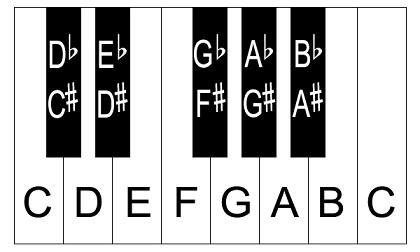It seems that a lot of guitarists have trouble learning their notes. In fact, some seem to outright avoid it (and I can’t imagine why). It really isn’t that complicated. I taught it to my 10 year old brother in just a few minutes. There really is no valid reason to NOT learn them either, especially if you’re serious about being a musician.
We’re going to start with a look at the keyboard (no, not that one in front of you, the piano keyboard). We’re doing this because, unlike the guitar, different notes actually look different on the keyboard.
So first we have the natural notes. These are the white keys on the keyboard. They are referred to by simple letter names that range from A to G and start back over from A again. Sometimes it is necessary (or just beneficial) to specify that you mean A Natural, C Natural, or any other natural note. When you need to do this, you can use this symbol: ♮ (click here for a larger, more detailed image)
Between the natural notes are the sharps and flats. Sharps are indicated by this symbol: ♯, while flats are indicated by this symbol: ♭. The sharp notes are those immediately above (to the right of) a natural note, while flats are immediately below (to the left).
So the black key immediately above a C natural note is C♯. The note immediately below a D natural note is D♭. So you can see here that this one note has multiple names. When you have notes (or even chords or scales) that sound the same, but have different names, they are said to be “enharmonic”. So A♯ is enharmonic to B♭, D♯ is enharmonic to E♭, get it?
You might also notice that there are no black keys between B and C or E and F. Does that mean that there is no such thing as B♯? Or F♭? Well… yes and no. There are times when it’s appropriate to write those notes, but for right now, let’s just say that there is no such thing.
So you may have guessed by now that each key on the keyboard is equal to one fret on the guitar. If you play a C on the guitar, then move one fret up, it’s C♯! If you play an E note and move one fret down, it’s E♭!
If you watch the video you will see a couple of really simple exercises to help you really drill this stuff into your head. The reason I’m not including tabs or anything like that here is because if I did, you would just memorize them instead of figuring it out. If you’re going to actually get this stuff into your head, you need to figure it out every time. It DOES take time, so be patient. If you work on this stuff for just a few minutes a night, it will start to take hold and you won’t have to think about it that much. You’ll just know.

